
The brown trout is a species of salmonid ray-finned fish and the most widely distributed species of the genus Salmo, endemic to most of Europe, West Asia and parts of North Africa, and has been widely introduced globally as a game fish, even becoming one of the world's worst invasive species outside of its native range.

The Atlantic salmon is a species of ray-finned fish in the family Salmonidae. It is the third largest of the Salmonidae, behind Siberian taimen and Pacific Chinook salmon, growing up to a meter in length. Atlantic salmon are found in the northern Atlantic Ocean and in rivers that flow into it. Most populations are anadromous, hatching in streams and rivers but moving out to sea as they grow where they mature, after which the adults seasonally move upstream again to spawn.
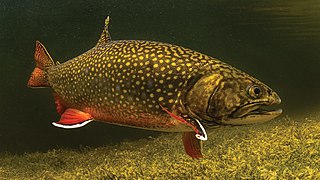
The brook trout is a species of freshwater fish in the char genus Salvelinus of the salmon family Salmonidae native to Eastern North America in the United States and Canada. Two ecological forms of brook trout have been recognized by the US Forest Service. One ecological form is short-lived potamodromous populations in Lake Superior known as coaster trout or coasters. The second ecological form is the long-living predaceous anadromous populations which are found in northern lakes and coastal rivers from Long Island to Hudson Bay, which are referred to as salters. In parts of its range, it is also known as the eastern brook trout, speckled trout, brook char, squaretail, brookie, or mud trout, among others. Adult coaster brook trout are capable of reaching sizes over 2 feet in length and weigh up to 6.8 kg (15 lb), whereas adult salters average between 6 and 15 inches in length and weigh between 0.5 and 2.3 kg. The brook trout is characterized by its distinctive olive-green body with yellow and blue-rimmed red spots, white and black edged orange fins, and dorsal vermiculation. The diet of the brook trout is restrictive to the season and location of the fish, but will typically consist of terrestrial and aquatic insects, fry, crustaceans, zooplankton, and worms.

Sea trout is the common name usually applied to anadromous (sea-run) forms of brown trout, and is often referred to as Salmo trutta morpha trutta. Other names for anadromous brown trout are bull trout, sewin (Wales), peel or peal, mort, finnock (Scotland), white trout (Ireland), Dollaghan and salmon trout (culinary).

Salmo trutta fario, sometimes called the river trout, is a river-dwelling freshwater predatory fish from the genus Salmo of the family Salmonidae. It is one of the three main subspecies of the brown trout, besides sea trout and the lacustrine trout.
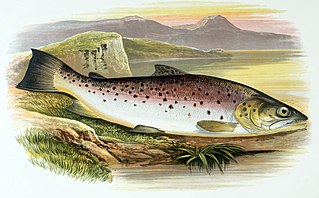
Ferox trout is a variety of trout found in oligotrophic lakes/lochs of Ireland, England, Scotland and Wales. Ferox trout is a traditional name for large, piscivorous trout, which in Scotland feed largely on Arctic char. It has been argued to be a distinct species, being reproductively isolated from "normal" brown trout of the same lakes, particularly in Ireland. However, it is uncertain whether the ferox of different lakes are all of a single origin. This fish grows to a length of 80 centimetres (31 in) SL.

The common river galaxias or Canterbury galaxias is a galaxiid fish of the genus Galaxias, found only in Canterbury, New Zealand.

The yoyo loach, Almora loach or Pakistani loach is a freshwater fish belonging to the loach family Botiidae. It originates in the slow-running and still waters of the Ganges basin in northern India and possibly Nepal. Despite the alternative common name Pakistani loach, the true B. almorhae is not known from Pakistan.
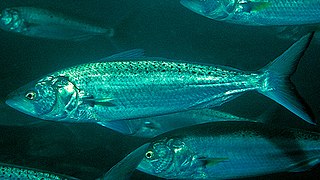
Arripis trutta, known as the Australian salmon in Australia and as kahawai in New Zealand, is a South Pacific marine fish and one of the four extant species within the genus Arripis, native to the cooler waters around the southeastern Australian coasts and the New Zealand coastline. Other common names for this species include Eastern Australian salmon, bay trout, blackback salmon, buck salmon, cocky salmon, colonial salmon, newfish and salmon trout.
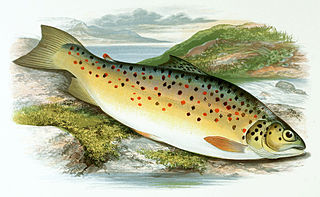
The gillaroo is a species of trout which eats primarily snails and is only proven to inhabit Lough Melvin in Ireland.

Capoeta, also known as scrapers, is a genus of fish in the family Cyprinidae found in Western Asia. The distribution extends from Turkey to the Levant, to Transcaucasia, Iraq, Turkmenistan, in Armenia, particularly in lake Sevan and northern Afghanistan. This genus is most closely related to Luciobarbus and in itself is divided into three morphologically, biogeographically and genetically distinct groups or clades: the Mesopotamian clade, the Anatolian-Iranian clade and the Aralo-Caspian clade. The Mesopotamian clade was split off to Paracapoeta in 2022.

Argyrosomus japonicus is a silvery to bronze-green colored fish, a member of the family Sciaenidae, which may grow up to 2 m in length. It is known as Japanese meagre (FAO), mulloway or jewfish in the eastern states of Australia, mulloway in South Australia, kingfish or river kingfish in Western Australia, and dusky kob, dusky salmon, salmon, Kob, or kabeljou in South Africa, Ô-nibe in Japan, Sawwa Krokar Fish or Sawwa Machli in Pakistan. The name jewfish refers to its large otoliths, which are prized as "jewels" by some fishers.
Capoeta caelestis, the Taurus scraper, is a species of freshwater cyprinid fish endemic to southern Anatolia, Turkey. It has a max length of 19.6 cm (7.7 in) long.

Capoeta damascina, the Levantine scraper or Mesopotamian barb, is a species of cyprinid fish from the Near East region. It is reported from Iraq, Israel, Jordan, Lebanon, Syria, Iran and Turkey.
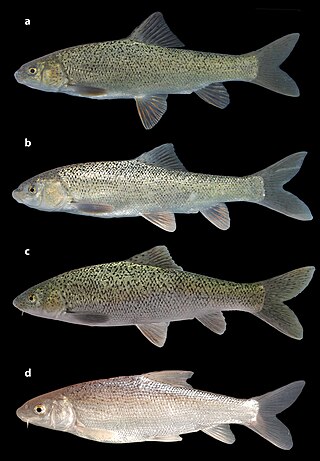
Paracapoeta erhani, also known as the Ceyhan scraper or Seyhan scraper, is a Turkish species of freshwater cyprinid fish in the genus Paracapoeta.
Capoeta umbla, also known as the Tigris scraper, is a Near East species of cyprinid fish. It grows up to 40 cm (16 in) standard length.

Piabucus is a genus of freshwater tetras in the family Iguanodectidae. All three species are found in South America, largely the Amazon and its major tributaries. None of them are longer than half a foot long, with the largest reaching a maximum size of 12.9 cm (5.1 in), and they are slender, with relatively deep chests and long pectoral fins. Their scales are pale or silvery, with lateral lines that stand out.
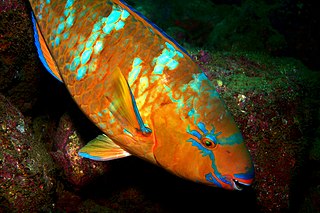
Scarus ghobban, also known as the blue-barred parrotfish, blue trim parrotfish, cream parrotfish, globe-headed parrotfish, green blotched parrotfish, yellow scale parrotfish, and bluechin parrotfish, is a species of marine ray-finned fish in the family Scaridae.
Salvelinus struanensis, commonly known as Scottish char, is a species of freshwater fish in the salmon family. It is found in the Loch Rannoch and Loch Ericht in Scotland, United Kingdom.

Paracapoeta is a genus of fish in the family Cyprinidae found in Mesopotamia, Cilicia and the Levant, Western Asia. This genus is closely related to Luciobarbus and was formerly the Mesopotamian clade of Capoeta before being split off in 2022. The generic name alludes to παρά meaning "near" and Capoeta.

















